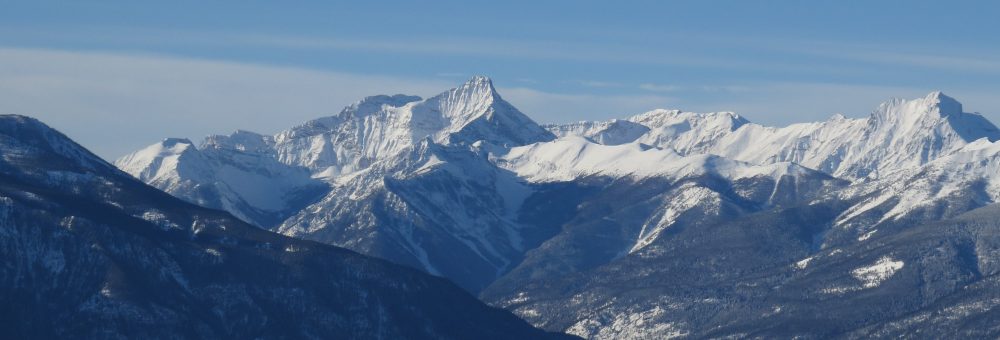Pert Peak, NW of Barn Mountain
Pert Peak is another of the “steamboat mountains”, named after a vessel that was, itself, known by a number of names.
Construction and Early Years
The vessel that became the Pert was originally built as a bateau in 1887 by Fred Wells, a young prospector who freighted goods on the Columbia River for several years. It was fifty feet long and ten feet wide (fifteen by three metres), constructed of coast fir with oak ribs, and was named after a Yagtsze River gun boat called the Alert.1
The Alert was purchased in 1890 by Captain Francis Armstrong for the Upper Columbia Navigation and Tramway Company as a low water boat to run in parallel with the Duchess on the Columbia River.2 Armstrong took the hull of the Alert (built by Wells) and fitted her with engines and paddles to make a paddle steamer that he called the Pert.3 It was smaller than the Duchess, the main boat run by Armstrong, and so served better in low water.
Operation on Columbia Lake
A year after her launch, the Pert was sent to run on Columbia Lake where it was operated as a one man boat under the command of a skipper-deckhand-engineer named George Drake.4 Drake became something of a legend for his unwillingness to bathe, and was known as ‘Dirty’ Drake.5 Captain Armstrong later told a story that after Drake was forced to take a bath, he was dead within a week.6 This seems to be apocryphal. Drake joined Armstrong on a trip to the Yukon in 1898,7 and later died in St Michael’s, Alaska of typhoid fever.8
The operation of the Pert on Columbia Lake was due in large part to the development of the Thunder Hill Mine claim. With the excitement of developing the claim, the Upper Columbia Navigation & Tramway Company constructed a tramway to connect Columbia Lake and Windermere Lake. The Pert was launched in Columbia Lake in July 1892,9 shortly before the last spike for the tramway was driven.10 With the tramway completed and the Pert in operation, the Upper Columbia Navigation Company had a 300 mile transportation service running between Golden B.C. and Jennings, Montana.11 It was also in an ideal position to start shipping ore from the mine.

Advertisement for the Upper Columbia Navigation & Tramway Company, The Golden Era, 29 July 1893, p 4.
Unfortunately the Thunder Hill Mine failed to meet expectations, and traffic on Columbia Lake was not enough to justify the Pert’s providing dedicated service there. It was instead moved as needed to operate sometimes on Columbia Lake and other times on the Columbia River.12 Armstrong had it withdrawn from service following the completion of the Crowsnest Pass branch railway line to the south in 1898.13
Carrying On
Again, the Pert was recycled. Its hull was purchased by Alexander Blakley and in 1899 was used to tow logs on Lake Windermere under charter for the Athalmer sawmill.14 Blakley also operated it as a low water boat opposite to Armstrong’s boat the Hyak.15
In 1901, the Pert was rebuilt with a propeller and launched as the City of Windermere.16 Blakley operated the City of Windermere between Golden and Windermere, mainly carrying freight.17
In 1903, the City of Windermere was purchased by Captain E.N. Russell and returned to the name the Pert.18 It ran for a couple years in opposition to the Upper Columbia Transportation Company until Captain Russell sold out and joined the company instead. The Pert was abandoned somewhere on Lake Windermere, disappearing entirely from the historical record.19 Pert Peak was likely named at a similar time, in the 1940s, to the other steamboat mountains (Duchess, Hyak, and Klahowya among others)
See Also
Captain Francis Patrick Armstrong
Thunder Hill Mine
Gwendoline
Duchess
Hyak
Klahowya
Footnotes
https://dx.doi.org/10.14288/1.0227166
